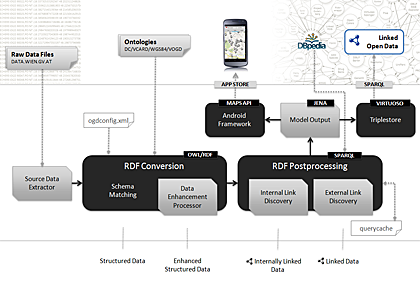Real-life Semantic Web Technology-based Information Sharing via Linked Data Concepts – Austria Linked Open Data (LOD) Project
My last post was the second in a series of “spotlight posts” I am using to illuminate practical examples of Real-life Semantic Web Technology-based Information Sharing via Linked Data Concepts. All of these examples support my proposed Enhanced Linked Data Architecture and its current incarnation as the Enhanced Linkeddata Architecture for Persistent Sharing Environments (ELAPSE)™.
My third post in this series is focused on the Austria Linked Open Data (LOD) Project, which:
“Follows examples in the U.S., EU, UK and Holland, implemented, on the basis of existing regional and national open records (Open Data) @ data.gv.at or data.wien.gv.at , a freely available Linked Open Data (LOD), infrastructure for Austria”1
A short video about LOD Austria on YouTube is here.
An Project Description of the Linked Open Data (LOD) PILOT Austria – presented at the PiLOD event at VU Amsterdam (Netherlands) on 29-01-2014 is here.
Freely available LOD takes the form of modeling and publication of ~30-50 most important basic data sets (e.g. postal codes, districts, public places, schools, school types, industry sectors, etc.) as LOD, which then results in an efficient and sustainable data publication and data sharing on the part of administration, economy, and society. Relevant data are identified, converted, and linked and are made available as LOD. Linked Open Data provides a method for delivering structured data for optimal reuse. The project has proven to be an important building block for a sustainable digital infrastructure in Austria.
The City of Vienna has played a leadership role in this project by stressing the usage of open standards for the interfaces and the software to allow for more transparency, participation, and collaboration. In addition to technical interfaces, a legal framework was also established by city administration. The City of Vienna’s Open Data site includes an extensive Data Catalog and a number of Applications that have been built upon the LOD base data formats.
For more technical details on the City of Vienna’s Open Data site and the overall Austria LOD-driven Open Government Data (OGD) initiative, go here.
From this site, links to the active SPARQL endpoint, the original RDF dataset, a Vienna Guide Android App, and the OWL Ontology can also be found.
A system architecture for the transformation of the various input data formats to LOD formats, usage of ontologies, and Android app access is shown below:

Vienna Linked Open Data (LOD) project architecture 2
As with previous “spotlighted” projects, this project has also attempted toaddress a number of the concerns, identified in one of my previous posts, that are commonly associated with today’s RDF Stores and Linkeddata Framework solutions. This project’s strong and successful ontology-based directions have proven that both short- and long-term benefits are achievable using Linked Data Concepts.
When focused on open source and open standards, this project does implement a number of the same components (the Enhanced parts) of my Enhanced Linkeddata Architecture for Persistent Sharing Environments (ELAPSE)™, including:
My next post will discuss a fourth practical example of Real-life Semantic Web Technology-based Information Sharing via Linked Data Concepts.
=david.l.woolfenden
